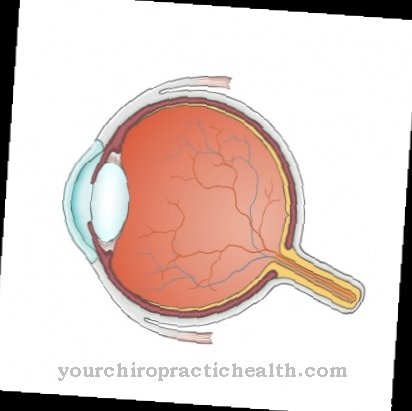The Functional position the hand represents the mechanically most favorable constellation for certain hand activities. Functional impairments can significantly reduce the quality of life.
What is the functional position?

The hand is the best controlled human organ of movement. The orderly interplay of many movement components allows numerous functional movement processes and postures to be carried out. From a biomechanical point of view, the functional position is the most effective position of the joints and rows of joints involved for activities that involve grasping and holding onto objects.
The wrist is held in a slight extension (approx. 25 ° dorsiflexion) and a slight outward deviation (ulnar deviation), with an inward rotation of the forearm (pronation). The thumb is slightly spread apart (opposition), the other fingers are in a slightly flexed position (flexion) in all joints.
The course of the long tendons of the finger extensors and flexors determines the positions that are most favorable for grasping activities. The extensors, which pull over the back of the hand to the end members of the fingers, are brought closer in the functional position and open the way for finger flexion. The finger flexors are slightly stretched by the wrist position and are passively pulled a little bit into the flexion so that complete closing requires little travel and strength.
Function & task
The functional position of the hand is often used when gripping and holding objects, regardless of whether all or individual fingers are used. Devices with a handle are often used in the household, in crafts or in sports. Due to the better development of strength, these are held with the fingers while the wrist remains in the functional position. The thumb lies diagonally over the index finger for support. This hand and finger position corresponds to an incomplete fist.
In the household, cleaning work is carried out with a broom, mop or vacuum cleaner, in sports activities with tennis, squash or badminton rackets. This hand position is also used when gardening with long or short-handled utensils.
The functional position of the hand is predestined for activities that require less effort but more fine motor skills.
As a rule, not all fingers are used, but often only pointing fingers. and middle finger in interaction with the thumb. In all joints, the posture during these activities corresponds to the functional position. Even if this is left when moving, the body always returns to the posture, as it is the most energy-saving. Needlework such as knitting, sewing, and crocheting are examples of such activities, but so is writing with a pen. The hand position ensures that the work can be carried out with the least possible effort and over a long period of time.
The functional position after injuries or operations in the hand area has a very specific task. It is used in the subsequent immobilization, as it has a much better chance of restoring functions. With little effort and only a few degrees of finger flexion, a good grip function can be achieved very quickly.
You can find your medication here
➔ Medicines for painIllnesses & ailments
Injuries to the hand or fingers can significantly impair hand function. Often, however, the subsequent immobilization in a plaster cast or in a splint is the more important factor in the development of restrictions if the setting has not been chosen correctly. In addition to fractures, ligament and capsule injuries in the finger area, it is above all the distal radius fracture that temporarily makes active assumption of the functional position impossible.
A special form of the disease that affects the functionality of the hand is Dupuytren's contracture, in which the tendon plate of the palm (palmar aponeurosis) fibrosis and shrinks. Starting with the little and ring fingers, all fingers are gradually drawn towards the palm and lose their mobility.
Peripheral or central nerve lesions can cause some or all of the muscles that are responsible for controlling the functional position of the hand to fail. The damage to the radial nerve leads to the appearance of the so-called drop hand, in which both the dorsiflexion of the wrist and the extension of the fingers can no longer be actively performed. Gripping is still possible with the fingers, but very insufficient due to the unfavorable position in the wrist.
A lesion of the median nerve in the area of the elbow affects the flexors of the wrist and fingers. In this case, there is no longer any active gripping function. If it is in the wrist region, as in carpal tunnel syndrome, only the thumb muscles and the flexors of the index and middle fingers are affected. Gripping with the other fingers is still possible as a residual function.
Paraplegia at the level of the 6th neck segment or higher also leads to a complete loss of hand functions, the functional position is no longer possible. In the case of nerve damage in which dorsiflexion is still actively possible but finger flexion is no longer possible, therapeutic attempts are made to create a so-called functional hand. This is achieved by placing the hand in specially made splints, which artificially shorten the finger flexors. Active dorsiflexion makes it possible to bring the fingers closer to the palm and to grip light objects.
Chronic polyarthritis can result in considerable loss of function. This autoimmune disease affects the wrist and fingers of the upper extremity. It is characterized by the fact that the affected joints are destroyed by intermittent inflammatory processes. Typical deformities arise that show both joint stiffness and instability. The functional position of the hand is often impaired very early on.



























